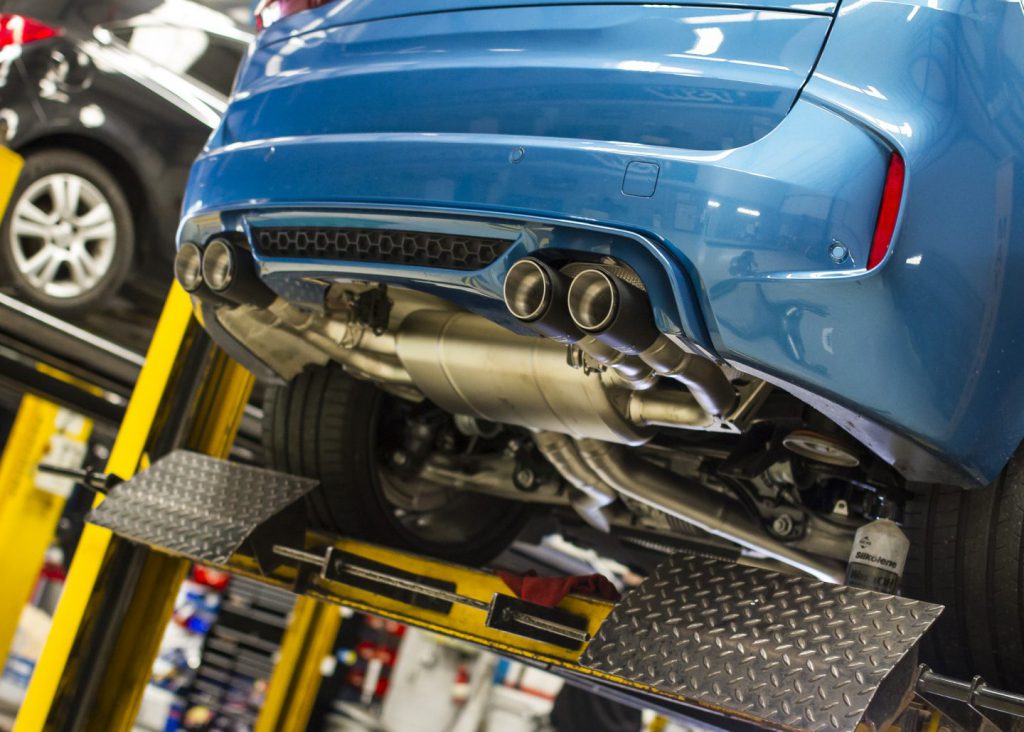
One of the most common upgrades that we see, and assist with here at Demon Tweeks, is the fitting of a performance exhaust. Switching the original, factory-fitted exhaust system for a high-performance exhaust can result in some significant gains in terms of horsepower, which is obviously of great benefit to lovers of speed and power; but there are a number of other reasons why you might want to upgrade – and plenty of questions around why, and how, too.
Over the years we’ve helped thousands of car owners to upgrade their standard OE exhausts to performance exhausts and along the way we’ve been asked a lot of questions. These range from the best brands when it comes to performance exhausts, what the overall benefits of the upgrade are and why people make the upgrade in the first place.
Here we’ve set out to answer some of the most common questions surrounding the wonderful world of sports exhausts to help you understand the true performance benefits.
We also think it’s worth taking a moment to explain all the different types of product on offer, because if you’re new to tuning the terminology can be a little confusing. But if you are interested in going down the rabbit whole further check out our Beginner’s Guide to Stage Tuning.
What is a performance exhaust and why do I want one?
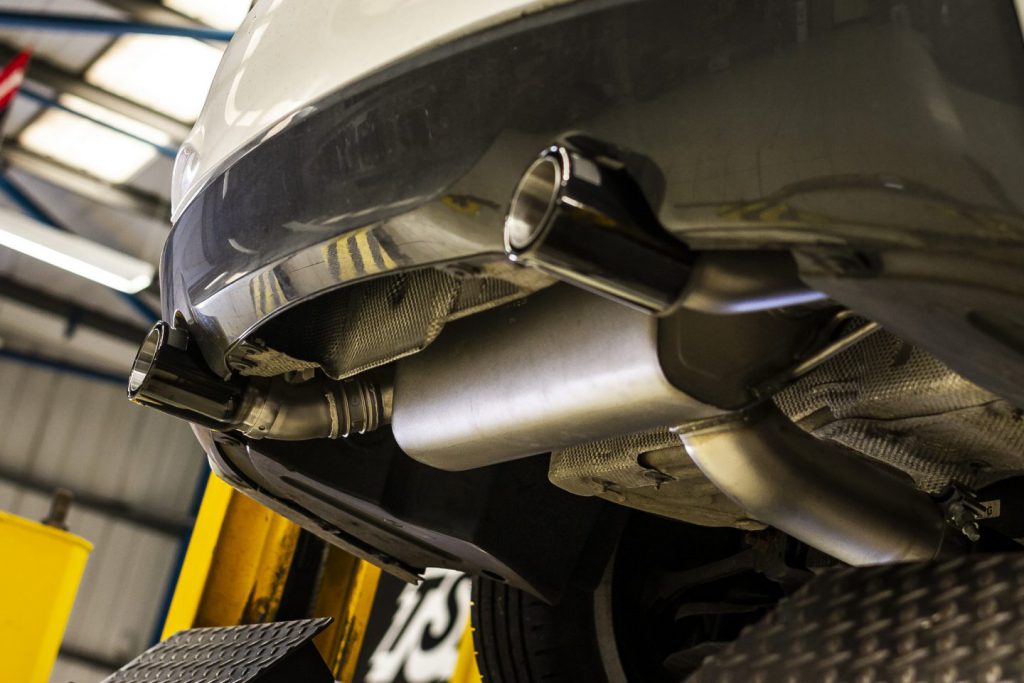
Put in the simplest possible terms, a performance exhaust system replaces some or all your car’s original exhaust system with improved pipework, silencers, and the like.
As with most things in life, your cars original exhaust will have been a bit of a compromise. Government standards and customer expectations for how quiet cars should be are increasingly strict, so it’s probably going to have been designed to favour quietness over performance and fun.
It will also have been designed for the original power output of the engine. It’s probably perfectly adequate for that power level, but once you start tuning the car it can become a limitation.
This means there’s two big areas for improvement for performance exhaust makers – sound and performance.
Sound
The sound is one of the biggest pull factors for some owners. A performance exhaust can transform the sound of a car. The combination of pipework and silencers mean each manufacturer can achieve their own trademark sound. While you probably notice the very loud aftermarket exhausts more, there’s actually a whole range of sounds on offer, depending on who’s exhaust you are fitting to your car.
This can range from the very boisterous through to a refined performance car sound. Most manufacturers will have a consistent quality to their sound.
You may also have a choice of different sounding exhausts from the same manufacturer. Many of them will offer similar exhausts with and without resonators (a silencer designed to cut out certain frequencies of sound) or silencers.
We’ll cover some of the top brands we do and how they like their exhausts to sound later.
Performance
A better flowing exhaust can help your car to generate more BHP. How quickly you can get the exhaust gasses out of the engine places a limit on how quickly you can get fresh air into the engine and thus how much power can be made. A better flowing exhaust always improves the power your engine can make. Performance exhausts achieve this in several ways. Pipework diameter, exhaust layout, and reducing obstructions in the exhaust all play their part.
On a non-turbo engine, it’s all about keeping the gas in the exhaust flowing quickly. The action of getting the exhaust gas out of the engine helps it draw in fresh air at certain parts of the rev range. The quicker everything is flowing, the more benefit you get from this. On a turbo-car, the big priority is increasing the flow-rate of the exhaust. The more gas the turbo can get out, the more efficiently it can force feed your engine with air at the other end.
While you will probably get some benefit from replacing any part of the exhaust system with performance parts, the benefits are most pronounced when you’re replacing the most restrictive parts of the original exhaust – which tends to be the catalytic converter and downpipe. When fitted alongside the correct software, you can get some serious power gains when you replace the original catalytic converter. Please note: Non type approved sports cats cannot legally be installed on a vehicle for use on public roads that was manufactured after 1/3/2001
Are there different types of performance exhausts?
If you’ve done a bit of research on this already, you’ve probably heard or read a lot of different terms for types of exhaust. While this might sound complicated, the difference is simply how much of your original exhaust system you’re replacing.
Cat-back, GPF-back, and DPF-back exhausts
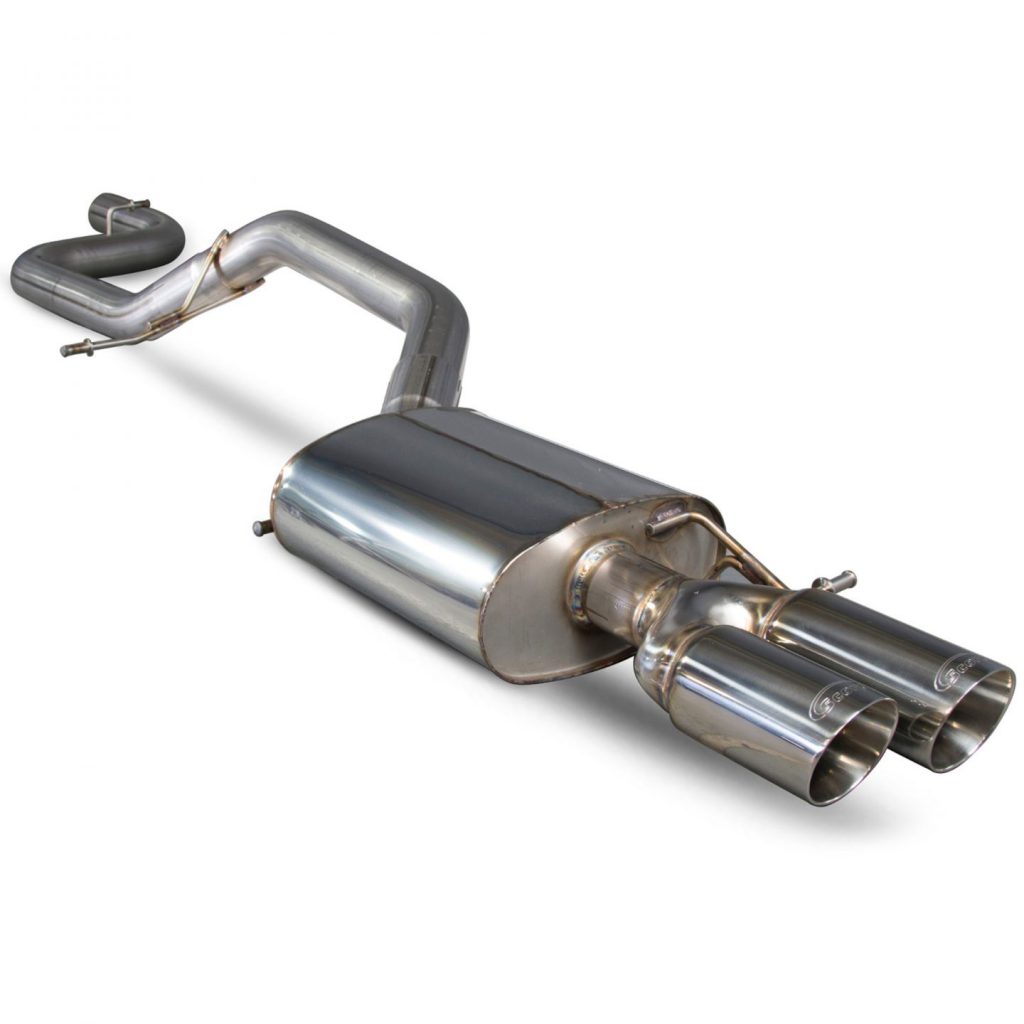
Perhaps the most widely adopted sports exhaust, a cat back exhaust is a performance upgrade from the catalytic converter to the end of the exhaust. This is normally about 2/3rds of the original exhaust system.
When you buy a cat-back exhaust you generally get the middle pipework which sometimes includes a silencer (depending on the make and model you choose), and the rear pipework, silencers, and tailpipes.
For cars with Gasoline (GPF) or Diesel-Particulate Filters (DPF), a GPF-Back or DPF-Back is almost the same thing. It connects behind the emissions hardware at the front of the exhaust.
Many 2018 and 2019 model year cars are adding a GPF to their exhaust systems to meet new emissions targets, so check carefully which type of exhaust you need if you drive a brand-new car.
A cat back exhaust is normally where you start seeing noticeable performance gains from an exhaust. You’re replacing enough of the pipework and silencers that the performance gains really start adding up. Exact figures will vary from car to car, so we cannot guarantee any exact power gain, but to give you some idea gains of around 10 BHP on the Fiesta ST180 were possible.
Turbo-Back exhausts

If you want to go all-in and don’t mind remapping, then a turbo-back exhaust is a highly effective performance upgrade.
Taking its name because, you guessed it, it replaces the exhaust system from the turbo back to the tailpipes; a turbo-back exhaust replaces the whole factory exhaust including the original catalytic converter.
This is either going to be getting replaced with a better performing sports catalyst, or a straight through section of pipe known as a de-cat. Both offer very similar power gains, because modern sport cats are very efficient.
It is worth bearing in mind that when you get to the stage of replacing the catalytic converter, a remap is often essential. The ECU (Engine Control Unit) will be set-up to work with normal sensor readings from the factory cat. When you replace or remove it, these are going to change a lot, which can read as a broken engine. This can result in your car going into limp mode or the check-engine light coming on, which is now an MOT failure. The remap tells the ECU what range of readings to expect and prevents any of this unpleasantness.
You also won’t fully unlock the extra performance available without telling the ECU it’s got a much wider downpipe to take advantage of.
PLEASE NOTE: If it comes with a de-cat pipe, then this is not road legal in the UK and Non type approved sports cats cannot legally be installed on a vehicle for use on public roads that was manufactured after 1/3/2001, they may also not be road legal in some other countries – so be sure to check your local laws before you buy or if you are going on a road trip to other countries.
Downpipe
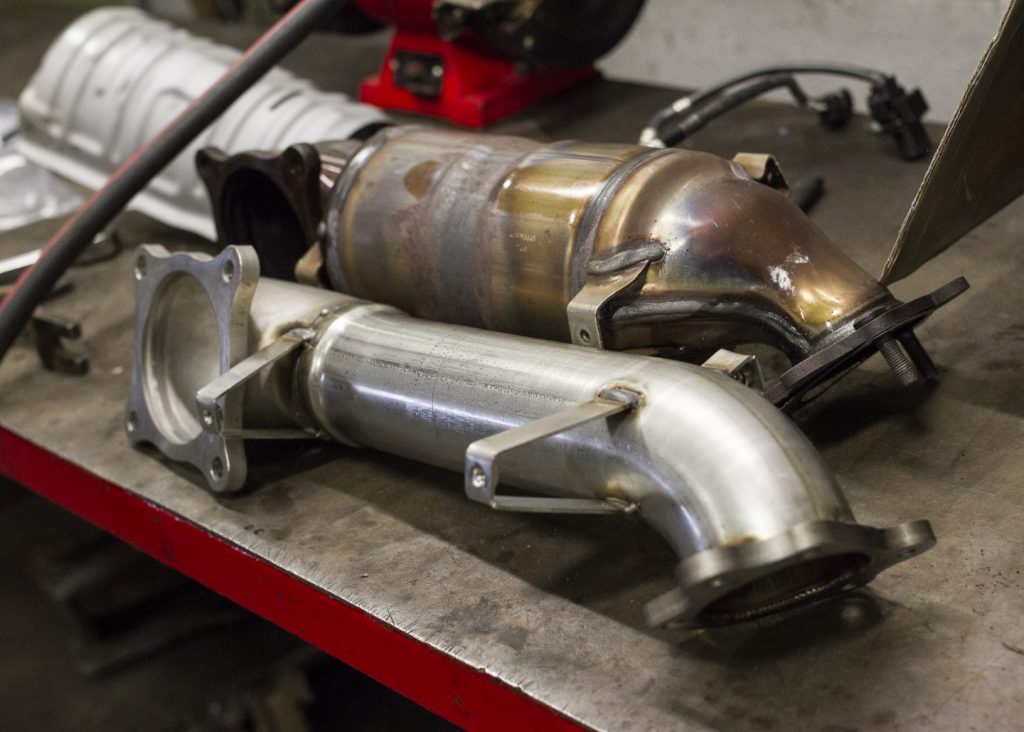
A downpipe is the section of exhaust connecting the turbo to the rest of the exhaust. If you’re fitting a turbo-back, you’re fitting a downpipe as part of that.
They are available as separate components too. If you’ve previously fitted a cat-back and now want to upgrade, that is an option on some cars. You can also just fit a down-pipe with the rest of the exhaust staying stock. As the original cat is the biggest restriction, some people like to start there when upgrading. PLEASE NOTE: Non type approved sports cats cannot legally be installed on a vehicle for use on public roads that was manufactured after 1/3/2001
The gains won’t be as good as doing a full turbo-back exhaust, because the exhaust gas is going to be flowing from bigger aftermarket pipework into the same old narrower factory exhaust.
This is normally where the Catalytic Converter/Gasoline Particulate Filter/Diesel Particulate Filter lives, so as we mentioned above you’re probably going to have to remap to ensure your car runs correctly and takes advantage of the extra performance on offer.
What do Resonated and Non-Resonated mean?
If you enter your car details you may notice that you have a choice between resonated or non-resonated, or between exhausts with different numbers of silencers. This is the manufacturer giving you the option to fine-tune how the exhaust sounds.
A resonator is a special type of exhaust silencer designed to cut out specific sound frequencies. These are normally designed to quieten your exhaust down at idle and low engine speeds. The idea is that your exhaust is quiet and well-behaved during normal driving (on the motorway for example) but comes alive during “spirited” driving.
On some exhausts you can replace one of these with a straight through pipe. This will increase the noise your car makes. This is all about personal choice. We’d suggest you think carefully about the type of driving you’re going to be doing with the car:
If you are going to be putting the miles in on a regular basis, there is something to be said for added refinement.
If the car only comes out for fun drives, more of the engines noise might add to the enjoyment.
What difference does the width of an exhaust make?
You may notice that for some cars there are a range of different diameters of exhaust on offer.
If you have a non-turbo car, bigger isn’t always better. Going too wide can make the exhaust flow slower at low revs and lose you a bit of torque.
On a turbo-car, this isn’t really the case and a bigger exhaust is usually going to support more power. How wide you need to go probably depends on your plans for the car. If you are leaving the engine untouched or going for modest bolt-on modifications, you will see power gains from any of the performance aftermarket systems we offer. If you have big plans in mind, going for a bigger exhaust when given the choice will help future-proof things a little.
What about cars with exhaust valves?
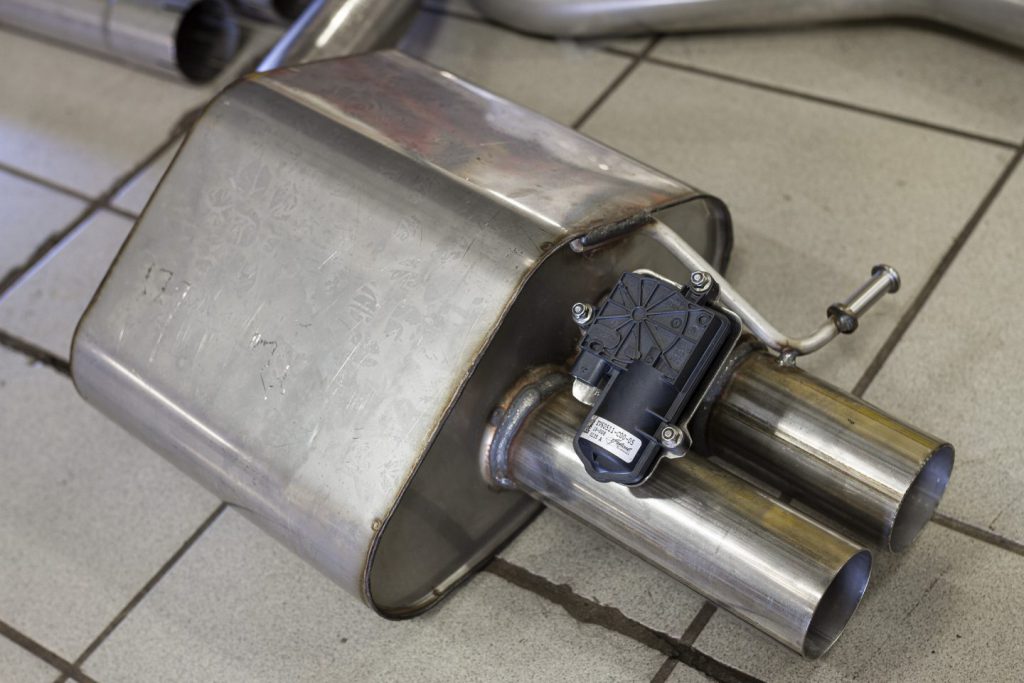
Increasingly if a car comes from the factory with electronically controlled valves in the exhaust system, you will have the option of aftermarket systems that accommodate these valves meaning you can enjoy both a better sounding aftermarket exhaust and the convenience of the adjustable exhaust sound.
What does a performance exhaust look like?
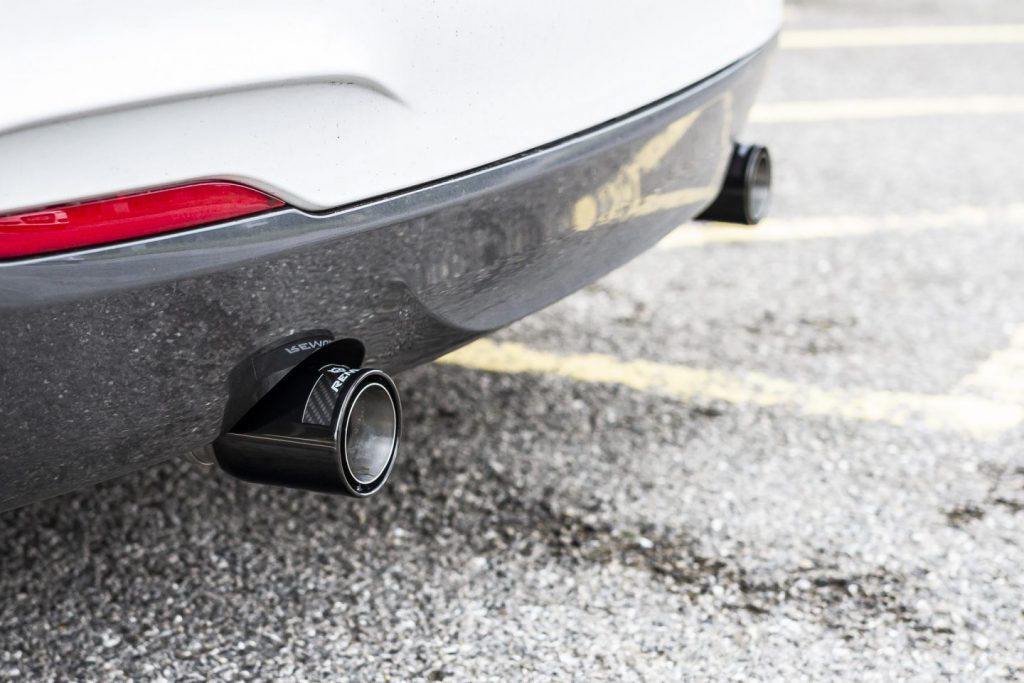
One benefit we haven’t really talked about is improving how your car looks. A set of shiny new tailpipes sat under your bumper is a subtle improvement, but one that jumps out to those with an eye for cars. Depending on what car you drive, there may be a couple of different styles of tailpipe to go for. These have usually been chosen by the exhaust manufacturer to suit the style of the car.
Most tailpipes are shiny high gloss stainless steel. Depending on what manufacturer you go for, you may also have the choice of matt black ceramic coating, titanium (burnt or polished), or even carbon-fibre. While this is a subtle change, it definitely adds to the visual appeal of your car.
You may also have the option of changing the styling of the tailpipe on your car. For some vehicles you can change a single sided exhaust to a dual-exhaust, or if your vehicle came with a discrete “behind the bumper” exhaust you might be able to switch to one that is more visible. Doing this may well entail swapping out your rear valance for one with more suitable cut-outs, but often this will be a readily available factory part from a different model in the range.
Who are the best brands for performance exhausts?
A lot of things can affect how an exhaust system sounds. Changing to stainless steel has an impact. The layout, diameter, and shape of the pipes also plays a part. Then there’s silencer choice and tailpipe design. As much work can go into tuning an exhaust as a musical instrument and the end-result is as much an art as a science.
It’s a little bit difficult to convey in text exactly how an exhaust sounds, so if possible, we’d always suggest seeking out a car with an exhaust fitted to listen to or hunting for videos. Video isn’t perfect of course – the quality of camera and how far away from the exhaust the microphone is can really change how something sounds.
That said, let’s look at some of our top brands.
Milltek
Big with the VAG scene, Milltek exhausts are popular for both the quality of their fit and finish, and for making very civilised sounding exhausts. More than most other brands, they take real care to ensure their exhausts are pleasant to drive every day of the year whether you’re going out for a blast round your favourite B-Roads or commuting in to work. The attention to detail and quality of engineering on offer here is genuinely outstanding. We’d describe the sound as being “refined performance car”.
Milltek are also big into new technology, offering exciting new developments like their “Active Sound” exhaust system which allows you to electronically tune the noise an exhaust makes. They are even developing exhausts for electric cars now!
Cobra Sport
Cobra exhausts have been making exhausts for five decades. Having started out with a wide range of performance exhausts for the Japanese market and models from the likes of Nissan and Toyota; Cobra Sports focus on performance and quality has been winning them fans all over the car tuning map of late.
Scorpion
Scorpion exhausts are heavily involved in touring cars and top-flight motorcycle motorsports. They reckon this gives their signature sound a bit of a motorsport flavour and a focus on performance. They cover quite a range of popular performance cars covering off everything from brand new applications like the Hyundai I30N through to tuner favourites like the Golf GTi, BMW, Mercedes, and Ford ranges.
Remus
Remus Exhausts are from Austria. Another company with a long and proud motorsport heritage, Remus are well known for the aggressive growl of their exhausts. Perhaps this isn’t surprising given their previous partnership with the AMG DTM team. It doesn’t get much more aggressive or growly than DTM.
Akrapovic
Akrapovic make fancy exhausts for fancy cars. With an application list that covers some seriously exotic machinery, Akrapovic offer exhausts that are made from the most expensive, lightweight materials including carbon fibre and titanium. This helps add the power and sound benefits without adding the extra weight. Perhaps best known for their range of professional motorcycle racing exhausts, Akrapovic are without a doubt the go-to brand if money is no object.
Jetex
Jetex focus on making quiet exhausts. Their slogan is “Performance to blow your mind, not your ears.” To this end they carefully engineer their exhausts to be civilised and quiet at low RPMs. This means you’re not annoying your neighbours on cold starts or yourself on long drives. They are also Swedish which means their range takes in more Saabs and Volvos than many other companies.
Piper
Ever popular among owners of Vauxhall and Ford are Piper exhausts. With a rorty sound to match some hooligan hot hatches, Piper have long been the go-to choice if you like your car with a blue oval or griffin on the badge. They have some deep and enduring love for British motoring as well with an interesting range of retro exhausts for retro cars.
HKS
HKS have been around since 1973 and are huge in the world of Japanese tuning. You can be forgiven for not having heard of them if you are not into that scene, but in their native Japan they are one of the biggest manufacturers of aftermarket parts, making everything from turbos, to oil filters, to coilovers, to engine management electronics.
Part of the range they offer is exhausts. HKS offer a lot of axle-back type systems which come with the rear-most silencers and pipework. Because they are from Japan they cover some JDM applications which few or no western manufacturers cover.

I’m very interested in your article on performance exhaust and I was wondering what’s available if anything for my 2020 Silverado Duramax 3.0 turbo diesel truck.